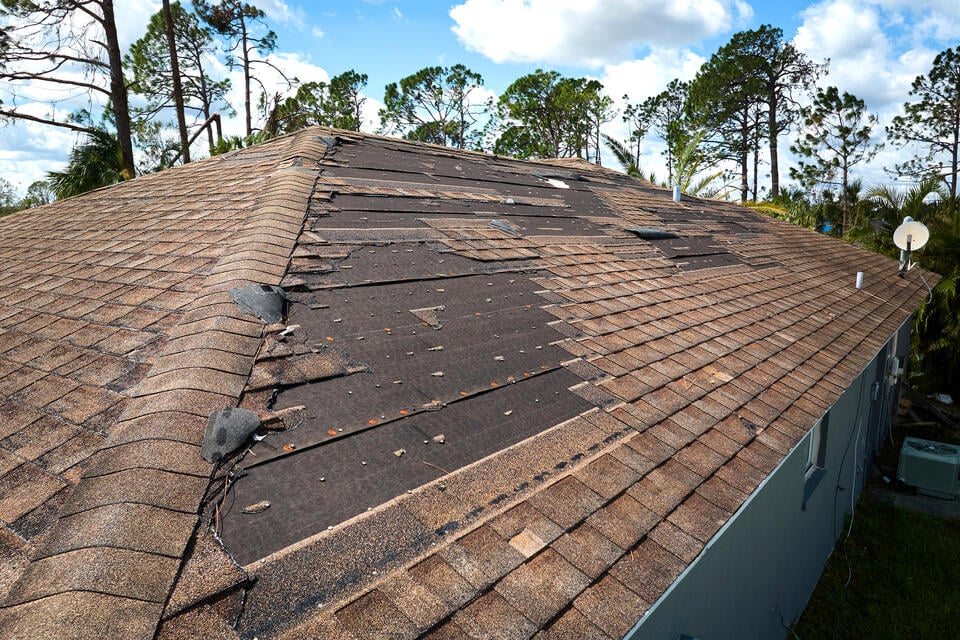
How Long Does It Take To Replace A Roof? (On Average)
When it’s time to replace your roof, one of the biggest questions homeowners ask is, “How long does it take to replace a roof?” It’s a fair question, especially when you’re planning around your busy schedule or weighing the cost and inconvenience of a construction project. The timeline to replace a roof depends on numerous factors, including the size of your home, the roofing material, and even the weather conditions. On average, it can take anywhere from a single day to several weeks. Here’s what we’ll cover:
- How different factors affect the timeline for replacing a roof
- The average timeframes for different roofing materials
- Why weather can play a big role in your roof replacement
- Tips to speed up the roof replacement process
⏳ 5 Factors That Affect the Timeline for Replacing a Roof

Understanding the factors that affect roof replacement timelines can help you plan effectively and avoid unexpected delays. This knowledge ensures your new roof is installed on time, protecting your home and budget.
1. Size of Your Roof
The size of your roof is one of the most obvious factors affecting how long it will take to replace. A larger roof requires more materials, more labor, and simply more time to complete. Contractors need to strip old materials, inspect the structure, and install the new roofing layer over the entire surface area. Here’s how this typically breaks down:
- Small roofs (less than 1,000 square feet): These are often found on smaller homes, like cottages or bungalows. A small roof can usually be completed in 1-2 days unless there are unexpected issues like structural damage or weather delays.
- Medium roofs (1,000-3,000 square feet): Average-sized roofs are common in most suburban homes. Replacement for these roofs typically takes 2-3 days as contractors carefully balance speed with quality to ensure long-lasting results.
- Large roofs (over 3,000 square feet): Larger homes or buildings with expansive roofs may take a full week or more to complete. These projects often require additional crew members, materials, and coordination to complete on time.
The size of your roof will also dictate other variables, such as material delivery times, equipment needs, and the cost of labor, all of which can influence the timeline.
2. Roofing Material Choice
The type of material you choose for your roof plays a major role in the timeline for replacement. Some materials are quicker to install due to their simplicity, while others require more time and specialized skill. Here’s an overview:
- Asphalt Shingles: As the most common roofing material in the U.S., asphalt shingles are lightweight, cost-effective, and relatively easy to install. A skilled crew can typically remove old shingles and replace them with new ones in 1-3 days, depending on the size of the roof.
- Metal Roofing: Metal roofs are increasingly popular for their durability and sustainability. However, installation can be more complex, requiring precise cuts and fittings. This adds to the timeline, with replacement usually taking 2-5 days.
- Clay or Concrete Tiles: Known for their aesthetic appeal and long lifespan, clay or concrete tiles demand meticulous attention to detail. Each tile must be carefully placed and secured, a process that can take 6-10 days or longer for larger roofs.
- Flat Roofs: Often used for commercial buildings or modern residential homes, flat roofs involve unique materials like rubber or PVC. These require specialized equipment and techniques, taking approximately 2-4 days to replace depending on the material and roof size.
It’s also important to consider the availability of materials. If your chosen material is out of stock or requires special ordering, this could add significant delays to the timeline.
3. Roof Complexity
The complexity of your roof is another critical factor. A simple, single-pitch roof is much faster to replace than one with multiple levels, angles, and features. Multi-level roofs, with different sections or varying heights, require additional planning to ensure proper alignment and waterproofing. Features like dormers, skylights, and chimneys add extra challenges, as they need to be carefully sealed and integrated into the new roof. Steep slopes are not only more difficult to work on but also pose greater safety risks, often requiring extra precautions and equipment that can slow down progress. Each added layer of complexity increases the time needed to ensure the roof is completed correctly and up to code. In some cases, complex roofs may also require specialized contractors experienced in working on unique roof designs.
4. Accessibility
Your property’s accessibility can significantly influence how quickly a roofing project can be completed. If the crew can easily access your roof and surrounding areas, the process will go more smoothly. However, certain obstacles can create delays:
- Trees and Power Lines: Overhanging trees or nearby power lines can make it difficult to get the necessary equipment close to your roof. Crews may need to trim branches or coordinate with local utility companies to safely work around these obstacles.
- Tight Spaces: Homes located in dense neighborhoods or with limited driveway space may require crews to transport materials and equipment over longer distances, slowing down the process.
- Roof Height: Taller buildings or roofs with challenging access points may require additional equipment, such as scaffolding or lifts, which can add time to both setup and teardown.
Addressing these accessibility challenges before the project begins can help minimize delays and keep the timeline on track.
5. Crew Size
The size of the roofing crew significantly impacts how quickly a job can be completed. Generally, larger crews can finish a project faster, as they can work on multiple sections of the roof simultaneously, which speeds up the overall process. However, large crews require more coordination and space to operate efficiently. On the other hand, smaller crews may take longer to complete a roof replacement, especially for larger or more complex roofs. Despite this, they often focus more on details, ensuring high-quality results. The crew’s skill and experience also play a crucial role. A smaller but highly experienced team may work faster and more efficiently than a larger crew with less expertise. Before starting your roof replacement, it’s essential to discuss the crew size and their approach with your contractor to set realistic timeline expectations.
🗓️ Average Timeframes for Roofing Projects

1-Day Replacements
The fastest roofing projects typically involve straightforward jobs using basic materials, such as asphalt shingles. These types of roofs are easier to work with because the materials are lightweight and simple to install. Roofing crews with experience and efficiency can often complete these jobs within a single day, especially if weather conditions are favorable. Smaller, single-story homes with uncomplicated roof designs—such as gable or hip roofs—are the best candidates for 1-day replacements. This quick turnaround minimizes disruption to homeowners and ensures the job is done with speed and precision.
2-4 Day Replacements
For most average-sized homes, roofing projects fall into the 2 to 4-day range. This timeframe accounts for slightly more complex jobs, such as replacing roofing materials like asphalt shingles, flat roofs, or metal panels. Medium-sized homes with varied roof slopes, additional features like dormers, or more complex structures require extra time to ensure every detail is addressed. Weather delays, material delivery times, and other external factors may also contribute to this range. Crews often use this time to ensure proper installation techniques and address any underlying roof issues, such as damaged decking or poor insulation.
5+ Day Projects
Larger and more intricate roofing projects can stretch beyond five days, sometimes lasting a week or more. Homes with elaborate roof designs, multiple levels, or extensive square footage require significantly more labor and time to complete. Additionally, projects involving heavy or specialized materials like clay tiles, slate, or wood shakes demand extra care during installation. These materials may also require reinforced structures due to their weight, adding to the project’s length. Similarly, older homes requiring structural repairs or custom solutions will extend timelines. These projects take longer, but the result is a durable, high-quality roof designed to last for decades.
⛈️ Weather’s Role in Roof Replacement Timelines
Weather is an unpredictable but crucial factor that can significantly impact the timeline of your roof replacement project. Rain or snow, for example, can bring work to a complete halt. Roofing materials like shingles cannot be properly installed on a wet surface, as moisture can compromise their performance and longevity. Wet conditions also create safety concerns for workers, making it impossible to proceed until the weather clears and the surface is dry.
Windy conditions are another challenge. High winds can make it unsafe for workers to handle and transport heavy or large roofing materials, which can lead to delays or even accidents. Installing materials like shingles or flashing under strong wind conditions risks improper placement, affecting the integrity of the finished roof.
Extreme temperatures, whether too hot or too cold, also play a role in delaying roof replacement timelines. In extremely hot weather, asphalt shingles can become overly pliable, making them difficult to handle and increasing the risk of damage during installation. Conversely, in bitterly cold weather, shingles can become brittle and prone to cracking, which not only complicates the installation process but also impacts the quality of the roof over time.
At Better Way Roofing, we understand the importance of adapting to weather conditions to ensure the success of your project. That’s why we closely monitor forecasts and adjust schedules accordingly, prioritizing both the safety of our workers and the longevity of your new roof. Our team is committed to ensuring your roofing project proceeds smoothly, no matter the season.
💡 Tips to Speed Up the Roof Replacement Process

A faster roof replacement minimizes disruption to your daily life and protects your home from potential weather damage. By streamlining the process, you can save time, reduce stress, and ensure your property stays safe and secure.
- Plan Ahead: Schedule your roof replacement during months with favorable weather conditions, as rain or snow can cause significant delays. Booking early also ensures you secure your preferred roofing crew during busy seasons.
- Choose an Experienced Roofing Crew: A skilled and reputable team, like Better Way Roofing, brings efficiency and expertise to the job, ensuring the work is done quickly without compromising on durability or quality.
- Make Your Roof Accessible: Preparing your property can save time. Trim overhanging branches, move outdoor furniture, and clear away any debris to give the crew easy access to the roof.
- Consider the Materials: Time-sensitive projects can benefit from choosing materials like asphalt shingles, which are not only cost-effective but also faster to install compared to other roofing options like metal or tile.
🙌 Quality Roof Replacement You Can Trust
At Better Way Roofing, we understand that replacing your roof is a significant investment, and you deserve a team that prioritizes your time, safety, and satisfaction. With years of experience, our skilled crew works efficiently to deliver high-quality results without cutting corners. We use only the best materials and stay proactive in monitoring weather conditions to ensure minimal delays. When you choose Better Way Roofing, you’re partnering with a company committed to excellence and transparency every step of the way. Contact us today for a free consultation.
